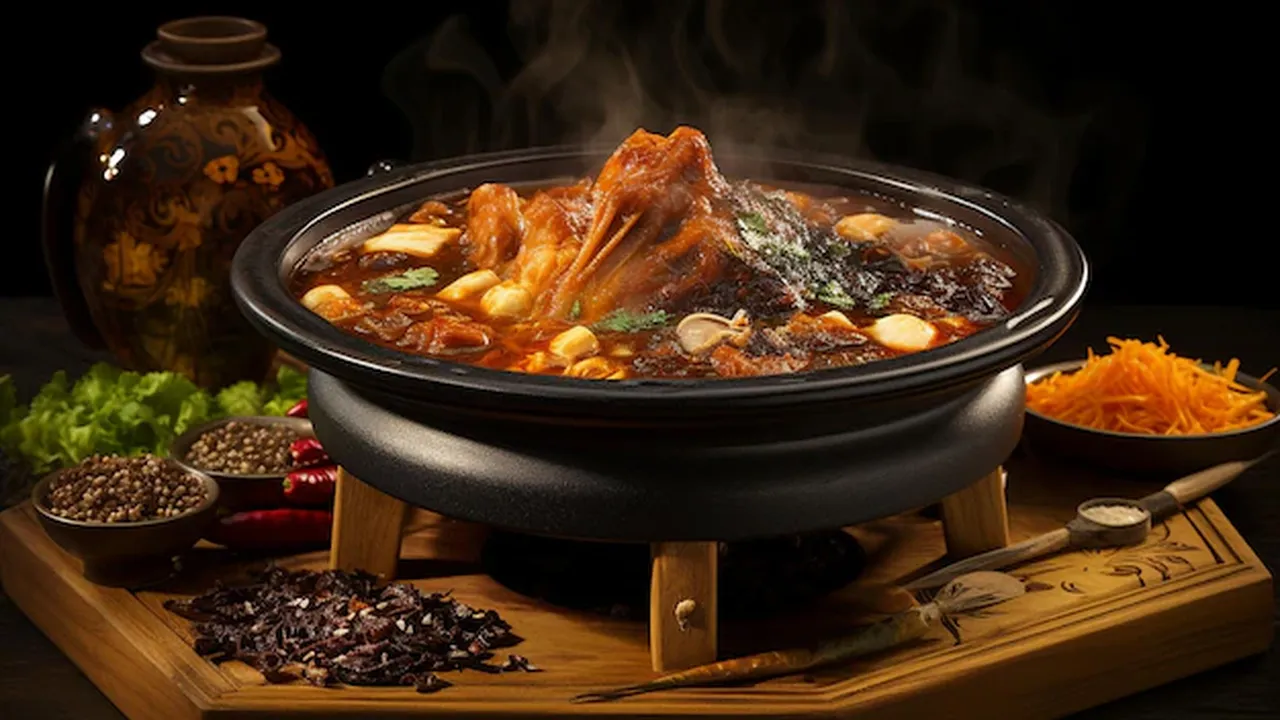Taiwanese Hot Pot: A Communal Dining Experience
Sample meta description.

A Deep Dive into Taiwanese Hot Pot Culture and History
Okay, let's talk Taiwanese hot pot, or "shabu-shabu" as some might call it. It's way more than just throwing ingredients into boiling water. It's a social event, a culinary adventure, and a comforting hug all rolled into one steamy pot. Think of it as a customizable feast where everyone gets to be the chef. But before we dive into the delicious details, let's rewind a bit and explore the history of this communal dining experience.
Taiwanese hot pot isn't just a recent trend. It's deeply rooted in the island's culinary history, influenced by various cultures and evolving over time. The concept itself is believed to have originated from Mongolian hot pot, which traveled to Taiwan and was adapted with local ingredients and flavors. Over the years, it's transformed into the diverse and vibrant hot pot scene we see today, with countless variations and regional specialties.
What makes Taiwanese hot pot so special? Well, for starters, it's incredibly interactive. Everyone gathers around a pot of simmering broth, selecting their favorite ingredients and cooking them to their liking. It's a chance to chat, laugh, and bond over shared food. Plus, the sheer variety of ingredients is mind-boggling, from thinly sliced meats and seafood to an array of vegetables, noodles, and tofu. And let's not forget the dipping sauces, which are essential for adding that extra layer of flavor.
Choosing Your Broth Base Exploring Diverse Flavors for Taiwanese Hot Pot
The broth is the soul of any good hot pot, and Taiwanese hot pot offers a dizzying array of options. Are you feeling adventurous? Then maybe a spicy Sichuan broth is your calling. Or perhaps you're in the mood for something more comforting? In that case, a mild chicken or pork broth might be just what you need. Let’s explore some popular choices:
- Mala (麻辣) Broth: This spicy and numbing broth is a staple for those who love a fiery kick. It's made with Sichuan peppercorns, chili peppers, and a blend of aromatic spices. It's definitely not for the faint of heart, but it's incredibly addictive.
- Herbal Broth (藥膳鍋): For a more medicinal and nourishing experience, try an herbal broth. These broths are infused with various Chinese herbs, believed to have health benefits. They have a subtle, earthy flavor that complements the other ingredients.
- Tomato Broth (番茄鍋): A tangy and slightly sweet option, tomato broth is a great choice for those who prefer a milder flavor profile. It's especially delicious with seafood and vegetables.
- Pork Bone Broth (豚骨鍋): This creamy and rich broth is made by simmering pork bones for hours. It's a classic choice that provides a hearty and satisfying base for your hot pot.
- Vegetarian Broth (素食鍋): For vegetarians and vegans, there are plenty of delicious broth options available. These are often made with vegetable stock, mushrooms, and other plant-based ingredients.
Don't be afraid to experiment and try different broths to find your favorite. Many hot pot restaurants offer the option to have multiple broth bases in the same pot, so you can sample a variety of flavors.
Essential Ingredients for an Authentic Taiwanese Hot Pot Experience
Now that you've chosen your broth, it's time to gather your ingredients. The possibilities are endless, but here are some of the must-have items for an authentic Taiwanese hot pot experience:
- Thinly Sliced Meats: Beef, pork, lamb, and chicken are all popular choices. The key is to slice the meat very thinly so that it cooks quickly in the broth.
- Seafood: Shrimp, squid, fish, and clams are all great additions to hot pot. They add a delicate sweetness and briny flavor.
- Vegetables: A wide variety of vegetables are essential for a balanced and nutritious hot pot. Popular choices include napa cabbage, bok choy, enoki mushrooms, shiitake mushrooms, and spinach.
- Tofu: Tofu comes in many forms, from firm tofu to silken tofu to fried tofu puffs. It's a great source of protein and adds a unique texture to the hot pot.
- Noodles: Udon noodles, ramen noodles, rice noodles, and glass noodles are all popular choices. They provide a satisfying carbohydrate component to the meal.
- Fish Balls and Meatballs: These are often made with a combination of fish, meat, and seasonings. They add a fun and flavorful element to the hot pot.
- Dumplings: Dumplings filled with meat, vegetables, or both are a delicious addition to hot pot.
Remember to choose fresh, high-quality ingredients for the best flavor. And don't be afraid to try new things! Part of the fun of hot pot is discovering new combinations and flavors.
Dipping Sauces The Secret to Perfecting Your Taiwanese Hot Pot
Dipping sauces are the unsung heroes of Taiwanese hot pot. They add that extra layer of flavor and complexity that takes the experience to the next level. Here are some common dipping sauce ingredients and combinations:
- Soy Sauce: A staple ingredient that provides a salty and umami base.
- Sesame Oil: Adds a nutty and aromatic flavor.
- Rice Vinegar: Provides a tangy and acidic counterpoint to the other flavors.
- Garlic: Adds a pungent and savory kick.
- Green Onions: Adds a fresh and herbaceous note.
- Chili Oil: For those who like a little heat.
- Sesame Paste: A thick and creamy paste made from ground sesame seeds.
- Sha Cha Sauce (沙茶醬): A savory and slightly spicy sauce made from dried shrimp, peanuts, and spices. This is a Taiwanese hot pot staple.
- Ponzu Sauce: A citrus-based sauce with soy sauce and rice vinegar.
Experiment with different combinations to find your perfect dipping sauce. A classic combination is soy sauce, sesame oil, garlic, green onions, and chili oil. But don't be afraid to get creative and try new things. Some people like to add a raw egg yolk to their dipping sauce for extra richness.
Recommended Taiwanese Hot Pot Products and Their Uses
To truly elevate your Taiwanese hot pot experience, consider investing in some quality products. Here are a few recommendations, including their uses, scenarios, comparisons, and prices:
Electric Hot Pot with Divider
Use: For cooking multiple broth bases at once. Great for accommodating different preferences.
Scenario: Perfect for family gatherings or dinner parties where guests have varying tastes.
Comparison: Traditional hot pots require a separate heat source (like a portable stove). Electric hot pots are more convenient and safer to use indoors. Some electric pots have temperature control features, allowing for precise cooking.
Price: $40 - $150 (depending on size and features)
High-Quality Sha Cha Sauce
Use: As a key ingredient in your dipping sauce. Adds a unique savory and slightly spicy flavor.
Scenario: Essential for an authentic Taiwanese hot pot experience. Use it as a base for your dipping sauce and customize it with other ingredients.
Comparison: Different brands of Sha Cha sauce vary in flavor and spiciness. Try a few to find your favorite. Look for brands that use high-quality ingredients and have a rich, complex flavor.
Price: $5 - $15 per jar
Thinly Sliced Meat Slicer
Use: For perfectly slicing meat for hot pot. Ensures even cooking and tender texture.
Scenario: Ideal for those who frequently host hot pot gatherings. Saves time and effort compared to slicing meat by hand.
Comparison: Manual meat slicers are less expensive but require more effort. Electric meat slicers are faster and more efficient but come at a higher price point.
Price: $30 - $200 (depending on manual vs. electric)
Hot Pot Ladles and Skimmers
Use: For easily retrieving cooked ingredients from the hot pot. Prevents cross-contamination and makes serving easier.
Scenario: Essential for any hot pot setup. Use ladles for serving broth and skimmers for retrieving ingredients.
Comparison: Choose ladles and skimmers made from heat-resistant materials like stainless steel or silicone. Look for ones with long handles to prevent burns.
Price: $5 - $20 per set
High-Quality Hot Pot Stock
Use: To create the most flavorful broth base.
Scenario: Essential for authentic and delicious hot pot. Use as a base and add your own herbs, spices, and vegetables.
Comparison: Compare different brands and flavors to find your favorites. Some stocks are pre-seasoned, while others are plain, allowing you to customize the flavor. Chicken and pork stock are very popular choices.
Price: $3 - $10 per carton
Tips and Tricks for a Successful Taiwanese Hot Pot Party
Hosting a Taiwanese hot pot party can be a fun and rewarding experience. Here are a few tips and tricks to ensure a successful gathering:
- Prepare in Advance: Slice the meats, wash the vegetables, and prepare the dipping sauces ahead of time. This will save you time and stress on the day of the party.
- Set Up a Buffet: Arrange the ingredients on a buffet table so that guests can easily access them.
- Provide Plenty of Plates and Utensils: Make sure everyone has their own plate, bowl, chopsticks, and dipping sauce dish.
- Keep the Broth Simmering: Maintain a gentle simmer throughout the meal. Add more broth as needed to prevent it from drying out.
- Cook Ingredients Thoroughly: Make sure all the ingredients are cooked thoroughly before eating them. Especially meat and seafood.
- Have Fun! Relax and enjoy the company of your friends and family. Hot pot is all about sharing and enjoying good food together.
So, there you have it – a comprehensive guide to Taiwanese hot pot! Now go forth and create your own delicious and memorable hot pot experience. Enjoy!
:max_bytes(150000):strip_icc()/277019-baked-pork-chops-with-cream-of-mushroom-soup-DDMFS-beauty-4x3-BG-7505-5762b731cf30447d9cbbbbbf387beafa.jpg)






